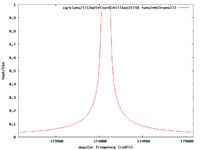Difference between revisions of "TF EIM Chapt3"
Jump to navigation
Jump to search
| Line 45: | Line 45: | ||
:<math>X_{L} = \omega L = 2 \pi \nu L = \frac{L}{\sqrt{LC}} = \sqrt{\frac{L}{C}} = \sqrt{\frac{33 \times 10^{-6} H}{1 \times 10^{-6}F}} = 5.7 \Omega</math> | :<math>X_{L} = \omega L = 2 \pi \nu L = \frac{L}{\sqrt{LC}} = \sqrt{\frac{L}{C}} = \sqrt{\frac{33 \times 10^{-6} H}{1 \times 10^{-6}F}} = 5.7 \Omega</math> | ||
| + | |||
| + | |||
| + | ;Bandwith: The most common definition for the Bandwidth of this circuit is the frequency range over which the output decreases by 3 dB | ||
| + | |||
[[Forest_Electronic_Instrumentation_and_Measurement]] | [[Forest_Electronic_Instrumentation_and_Measurement]] | ||
Revision as of 05:52, 2 February 2011
gain
Loop Theorem
or
- Notice
- When then the AC signal is attenuated.
Looking at the Voltage divider aspect of the circuit
| and and R=200 |

|
| rad/s or Hz |
Q and Bandwidth
In the above circuit
The inductors reactance at this resonance frequency is
- Bandwith
- The most common definition for the Bandwidth of this circuit is the frequency range over which the output decreases by 3 dB